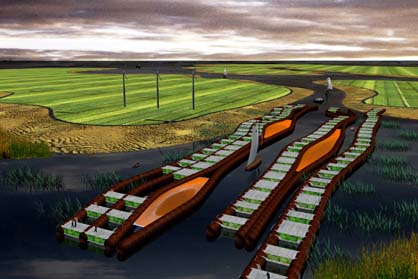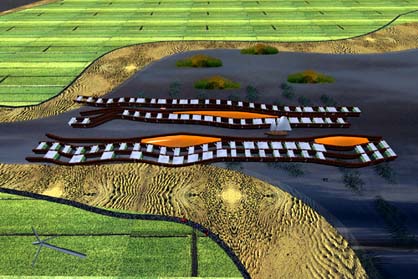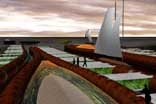|
|
||||
| FLORENT
ROUGEMONT. Amphibious living |
||||
| [in
italiano] [en français] |
SUMMARY. This proposal considers the site as first half of the project. It originates at the encounter of the pre-existent environment and the floating amphibious architecture opened on the former one. One can feel everywhere an intimate contact with wild elements, always in a safe position though: wild screens. Hence a merging and an ecological relationships are established. PROGRAM. Adaptability of the project to the geographical characteristics of every soils: land, water and unstable surfaces such as marshy, sandy, icy areas and lands liable to flooding. 125 dwellings for a surface of 5 hectares (450 inhabitants, 115m2/inhabitant). Industrialized process of building, including making, forwarding and assembling. Geographical similarity of the designed site with the delta's one. |
[05apr2001] | ||
 PROPOSAL. This proposal is guided by the morphological rules of its main component: the floating tube. Bunch of floating pipes adaptable to different geographical characteristics Different intervals between tubes dedicated to : local traffic depending on the environment, dwellings in cross-bar houses spaced out by aquatic areas and collective and leisure programs. |
Florent Rougemont, born in 1973 in Grenoble, France. He studied architecture in Lyon and Strasbourg from where he graduated in 1998. He collaborated with different offices in France and currently working in Holland. He participated in different competitions,
The City, less aesthetics, more ethics for the 2000 Venice Biennale, and recently designed an animation for the
5th International Festival for Architecture in Video in Firenze. Actually, he is working on a bicycle shelter project for the Art's school of Strasbourg, a competition he won this last summer. His work is engaged in different fields, urban planning, architecture, design mixing virtual and real projects. |
|||
  |
PROCESS. The totality of building units are made in factory. Prefabricated pipe sections and prefabricated metallic skeleton of houses are forwarded to the site in order to be assembled and put in their final location (anchorage). Houses are situated between the floating tubes and they integrate the inner space of pipes. The final step of the process can also be achieved by inhabitants who can undertake the design of the living space and of the platform roof. |
|||
| TRAFFIC AND ACCESS. Pedestrian ways are situated along pipes and the platform roof works as a link. It allows pedestrians to pass from one tube to another. Accesses to houses is either possible from an inside gallery or from a staircase situated in the court yard. DWELLINGS. On both sides of the lower platform of units (65 m2), one has access to the facilities spaces (45 m2: kitchen, bathroom, bedrooms etc.) located in the encircled part of pipes. COLLECTIVE PROGRAMS. Programs dedicated to leisure (an Amazonian biotop, a swimming pool and an ice rink) are situated under transparent dome. |
   |
|||
 |
SPECIFIC CHARACTERISTICS OF THE PROPOSAL. Floating tubes are at once support, links, boundaries and part of houses. The different working processes of pipes converge in the house. They undertake the transmission of fluids and webs. Domestic sewage is stocked in certain parts of pipes in order to be biologically recycled before its restitution to the environment. Certain parts also undertake the ballasting required for stability. Thanks to partition walls, tubes are divided in separated sections fitted out with water pumps controlled by computing. Pipes always propose a propitious site for settlement. Wind slides above the general shape of the project. The location of the houses and gardens protects them from high and usual wind. The proposition fit to the landscape without spoiling it and without damaging the ecological system. This peculiarity and flexibility could make possible a decolonization process. Florent Rougemont roug_f@yahoo.com |
|||
| Amphibious
living. International Idea Competition organised by the South Holland province for the festival of the Art of Creative Water. Project realised in March 2000 in Rotterdam. Project team: Florent Rougemont and Olivier Greder. |
||||
|
>
ARCHITETTURE |
||||
per partecipare alla rubrica architetture laboratorio
|
||||